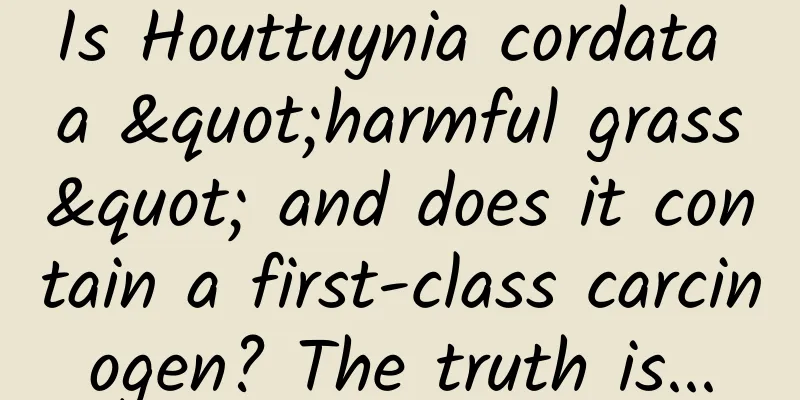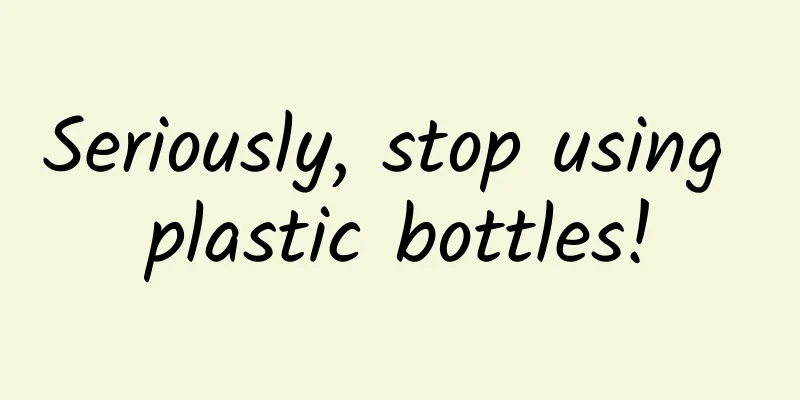Is Houttuynia cordata a "harmful grass" and does it contain a first-class carcinogen? The truth is...

|
Author: Wang Yanli, registered dietitian Reviewer: Zhong Kai, Director of Kexin Food and Health Information Exchange Center Houttuynia cordata, also known as Houttuynia cordata, is a kind of wild vegetable in the southwest region that is both a medicine and a food. But people who dislike it say that the smell is like 10 times the concentrated smell of fish plus the smell of soap, and some say it is like rotten snails, and you can't wait to spit it out immediately after taking a bite. In the eyes of people in Yunnan, Guizhou and Sichuan, it is a must-have delicacy for daily eating and eating. This really proves the saying "outsiders say it smells bad, locals say it smells good". However, the controversy surrounding Houttuynia cordata is not just about its reputation for being unpalatable. More people are discussing whether it is a harmful weed. Will it damage the kidneys or cause cancer? Is this true or not? And why do people in the southwest region still eat it so often? Let's analyze it in detail today. Copyrighted stock images, no reproduction is authorized 01 Rumor: Houttuynia cordata really has anti-inflammatory effects Analysis: It’s fake, don’t count on it; it doesn’t have the frying and heating functions. Houttuynia cordata has certain antibacterial and anti-inflammatory effects, mainly because it contains a chemical called houttuynia cordata. However, in most cases, houttuynia cordata is only eaten as a vegetable, and frying or heating will destroy the houttuynia cordata, which will have no antibacterial effect. Therefore, it is not recommended to take houttuynia cordata as a medicine. Moreover, when Houttuynia cordata is used as a medicine, it is mainly in the form of oral liquid and granules, but it still has certain side effects, such as dry throat, heartburn, palpitations, trembling hands, etc. Therefore, when taking such medicines, be sure to consult a doctor or a licensed pharmacist. Copyrighted stock images, no reproduction is authorized 02 Rumor: Houttuynia cordata contains the toxic substance aristolochic acid, which can cause kidney damage or even cancer after consumption Analysis: False. In fact, Houttuynia cordata does not contain aristolochic acid, but aristolochic acid lactone, which are two different substances. Aristolochic acid, which is classified as a Class 1 carcinogen by the International Agency for Research on Cancer, is indeed harmful to the kidneys. It is a special component contained in plants of the genus Aristolochia. So what does this have to do with Houttuynia cordata? Houttuynia cordata contains aristolochic acid lactone, which is a metabolite of aristolochic acid in the liver and a component that exists independently and widely in nature. [1] However, Houttuynia cordata does not belong to the genus Aristolochia, but belongs to the genus Houttuynia of the dicotyledonous plant family Saururaceae in plant taxonomy. From the perspective of plant attributes alone, they are different orders, families, and genera (botany classification: kingdom, phylum, class, order, family, genus, species). The difference is more than a little bit, and can be compared to the difference between "rabbits and tigers" in the animal kingdom. In fact, the official Chinese name of Houttuynia cordata is Houttuynia cordata. Because people often dig out the roots to eat, it has the common name "Houttuynia root". Over time, it evolved into "Zhe Er Gen" in the southwestern dialect. 03 Rumor: I heard that the toxic aristolochic acid lactone I is present in Houttuynia cordata Analysis: False. The two most toxic substances, aristolochic acid and aristolochic acid I, were not found in Houttuynia cordata. Aristolochic acid lactone is a general name for a large class of compounds, some of which are indeed toxic. Among them, aristolochic acid lactone I is the main toxic component. It is one of the metabolites of aristolochic acid I in the human body and is involved in renal cell toxicity. In other words, aristolochic acid and aristolochic acid lactone are not simply a certain substance, and not all aristolochic acid lactones will damage the kidneys. Only aristolochic acid AII, aristolochic acid BII, and aristolochic acid FI have been isolated from Houttuynia cordata. Currently, only in vitro cell experiments have proven that Houttuynia cordata extracts contain toxic substances, and the damage to liver cells is greater than the cytotoxicity to kidney cells. [2] Further safety evaluation methods such as in vivo experiments are needed for further evaluation. 04 Rumor: It is best not to eat Houttuynia cordata, as it is poisonous Analysis: False, too absolute. It is not that Houttuynia cordata cannot be eaten, but there is no exact value for the safe amount. Combined with the current scientific research data on Houttuynia cordata, the overall evidence that it is toxic is relatively weak, so there is basically no need to worry. The content of total aristolochic acid in Houttuynia cordata is much lower than the content of aristolochic acid in toxic herbs. To be honest, using the critical dose of aristolochic acid as the herbal medicine, the dosage of fresh Houttuynia cordata to reach the toxic dose is 2.3-60kg/d. [3] As we know, Houttuynia cordata itself is not a daily staple food, and people don’t eat 4 or 5 kilograms a day. The amount of consumption itself is also very limited. The most intuitive thing is that even though people in Yunnan, Guizhou and Sichuan have the habit of eating Houttuynia cordata all year round, so far, no case of kidney damage and poisoning caused by eating Houttuynia cordata has been heard. It is worth mentioning that compared with Houttuynia cordata, eating barbecue and smoking are more likely to cause cancer, and some people like to eat and smoke. This involves different people's acceptance of known risks. For example, people in the southwest or those who like to eat Houttuynia cordata know that it is "toxic", but they still eat it, because after weighing the pros and cons, they find that the health risks it brings are less than the pleasure of eating it. Therefore, it is enough to be aware of the risks and eat a reasonable diet. There is no need to kill with one stick and directly define it as edible or not edible. Eat some if you want. It is definitely okay to satisfy your cravings when it is in season. However, during special physiological stages such as pregnancy and lactation, I think it is not recommended to eat it for the sake of caution. Copyrighted stock images, no reproduction is authorized in conclusion Houttuynia cordata does not contain carcinogenic aristolochic acid or toxic aristolochic acid I. Overall, the evidence that it is toxic is still weak. It is okay to eat it occasionally to satisfy your cravings, but don't expect it to have an anti-inflammatory effect, as heating will destroy its anti-inflammatory components. Furthermore, the side effects of Houttuynia cordata as a drug should not be underestimated, so use it with caution under the doctor's advice. References: [1] Gao Bin, Li Guifeng, Sun Qiaosheng, et al. Study on hepatotoxicity and chemical composition of Houttuynia cordata[J]. Chinese Journal of Traditional Chinese Medicine and Pharmacy, 2021, 28(04): 564-567. [2] Wu Yingxue, Kang Shuai, Li Yan, et al. Isolation and identification of lactam alkaloids from Houttuynia cordata under the guidance of hepatorenal cell toxicity[J]. Modern Chinese Medicine, 2023, 25(03): 544-548. DOI: 10.13313/j.issn.1673-4890.20220623007. [3] Yin Mingxing, Chen Jing, Shi Chunyang, et al. Exploring the safety of Houttuynia cordata from the perspective of aristolochic acid lactone[J]. Chinese Herbal Medicine, 2021, 52(19):7. The article is produced by "Science Refutes Facts" (ID: Science_Facts). Please indicate the source when reprinting. The cover image and images within this article are from the copyright gallery. Reprinting and quoting them may lead to copyright disputes. |
<<: Inflate, deflate, inflate, deflate, inflate...can't deflate anymore!
Recommend
U-PONTEK appeared at the Communications Exhibition to fully explain the current status of the Internet TV industry
On September 23, the "2014 China Internation...
How does Baodao Glasses manage user operations?
The company I’m going to dissect for you today is...
Vitamin D has so many benefits, the more you take, the healthier you will be? Be careful of poisoning!
Expert in this article: Li Xue, Peking Union Medi...
Google almost wasn’t the Google it is today
Google co-founders Larry Page and Sergey Brin rece...
Starting from 93,800 yuan, BYD Dolphin is the right choice for you, with good looks, large space, strong power and intelligence.
On August 29, BYD Dolphin, a "new pure elect...
How can education and training companies leverage hot marketing trends to boost brand communication?
In the fragmented Internet era, the rich media in...
Analysis of competing live streaming apps: In the battle for national time, how can live streaming apps gain users’ usage time?
Live streaming is a form of Internet content diss...
What does SEO strategy mainly include?
What does SEO strategy mainly include? A few year...
Can the establishment of a car rental company break the deadlock?
As the discussion on "private cars" con...
Telecom Open Platform Releases In-App Billing SDK to Help Apps Make Small Amounts of Quick Payments
Abstract: In early September, China Telecom Tiany...
Which specific reports should I look at to analyze Baidu bidding account data?
Recently, I have often come into contact with som...
Be careful! If you see these symptoms, you must pay attention to them, or they may be signs of illness!
Reviewer of this article: Chen Sijiao, Chief Phys...
The shared bike graveyard: the aftermath of crazy development
After nearly a year of crazy development, the dev...
Why do 5G mobile phones support more frequency bands?
How many 5G frequency bands a mobile phone can su...









